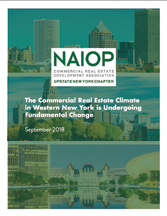Facts Drive NAIOP Advocacy at the Local Level

Reports from two chapters demonstrate the value of targeted research when it comes to influencing policymakers.
Good policies transcend politics. That is true in Washington, D.C., of course, but also at the state and local level. Across the United States and Canada, NAIOP chapters are leading advocacy efforts in their communities on important issues surrounding the commercial real estate industry.
Recently two chapters, Upstate New York and Chicago, put together important reports showing the benefits of economic growth in their regions and recommending strategies to work with governments to maintain that growth. Both studies focus on delivering facts rather than opinions. Factual information is a fundamental principle of effective advocacy that has provided leverage in the policymaking process, giving both of these chapters a seat at the table with local officials.
Spurring Growth in Buffalo
In Upstate New York, a recent white paper entitled “The Commercial Real Estate Climate in Western New York is Undergoing Fundamental Change” delivered useful data and important policy recommendations to help encourage growth.

Download NAIOP Upstate New York’s report “The Commercial Real Estate Climate in Western New York is Undergoing Fundamental Change.”
“After generations of languishing in the economic doldrums, the last several years have seen a noticeable uptick in economic activity in Buffalo and western New York,” the report finds. “Our region is at that juncture where it needs to advance beyond the traditional approach to economic development, proactively recognize emerging economic trends and development, and implement a series of new policies to position our economy to maximize the benefits of these new trends.”
The report recommends specific steps policymakers could take. To begin, the region’s governing bodies need to revise zoning standards to make it easier to build the housing and industrial property people need.
Buffalo has one of the lowest vacancy rates in the nation for industrial buildings, yet it has virtually no industrial space in development. To fill that need, local policies should provide incentives for developers to provide “move-in-ready” industrial space as opposed to “shovel-ready” parcels of land that still need to be developed.
At the same time, governments should take steps to make more of their underutilized property available for development.
“In western New York, much of the desirable land is controlled by government and what land isn’t requires at least a pilot agreement in order to make a speculative development viable,” the report finds. “Thus, government action is required to address the market conditions.”
Also, the report explains that western New York needs better housing policies. It does not require policy interventions to lower the cost of housing; the median price of a house in the city of Buffalo in 2017 was just $80,000. Instead, development agencies should move to incentivize the market, “including removing housing stock, expanding the boundaries of thriving neighborhoods and encouraging investment in single-family houses.”
Talking Tax Benefits in Chicago
NAIOP’s Chicago chapter released a study, “TIF Success Stories: Funding Local Economic Development in the Chicago Region,” that highlights the important economic activity driven by a particular policy approach: Tax Increment Financing (TIF).
TIF creates public-private partnerships “that can help remedy site development barriers such as environmental contamination, lack of public infrastructure, or other ‘extraordinary’ costs that private developers do not undertake on their own or that make a project unfeasible,” says the report, co-authored by NAIOP Chicago and SB Friedman Development Advisors.
It provides case studies of five Chicago-area projects that were made possible because of TIF, which allocates increases in property taxes in a given area (TIF district) to pay for improvements within that area. Because TIF funding reallocates government spending, some worry it will take money from other important areas, such as schools. However, as the report notes, “strategic investments should, in the long term, strengthen the overall tax base and fiscal foundation of local taxing bodies.”
The economic benefits of the five projects cited in the report include:
Leveraging public investment. In each case, private investment in the TIF regions far exceeded public investment. In one case, TIF spending of $300 million brought in $1 billion in private investment. In another, an investment of $2.8 million by a TIF led to $41 million in private spending.
Creating economic activity. Economic value came in the form of new development, new employment opportunities, or an influx of residents to a previously uninhabited site.
Increasing tax base. Each project created a new source of tax income for governments in the region. TIF-funded redevelopment projects in the five case studies triggered growth in area Equalized Assessed Value of between 1.4 percent and 38.3 percent. According to Chicago-based Kensington Research and Recovery, the Equalized Assessed Value of a property is “the product of the assessed value of your property (both land and improvements) and the State Equalization Factor, which is set by the Illinois Department of Revenue.”
Radiating benefits. Together, the TIF projects resulted in the creation of thousands of jobs, ranging from 173 at one location to 8,300 at another project.
“The cases are varied not only in their location within the Chicago region, but also in their project goals, land uses, scale and surrounding demographics,” the report points out. But each is tailored to its neighborhood, and each is creating partnerships between governments and private investors.
Get Involved
Whether it is affordable housing, TIFs or another policy initiative, it is important for NAIOP chapters to remain proactive and engaged in the policymaking process. Legislative issues can often start as an idea in a single city or community, then spread across a state or province and then throughout North America.
These reports show the influence that facts can have in driving the local policy debate. By standing for issues relevant to their communities, these chapters are making a difference on behalf of NAIOP and commercial real estate. Local policymakers are listening.
Rich Tucker is NAIOP’s director for public policy communications.


